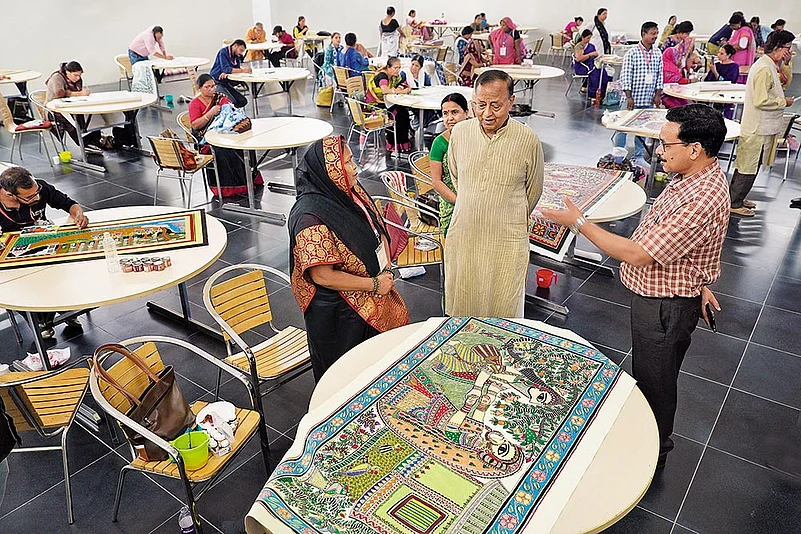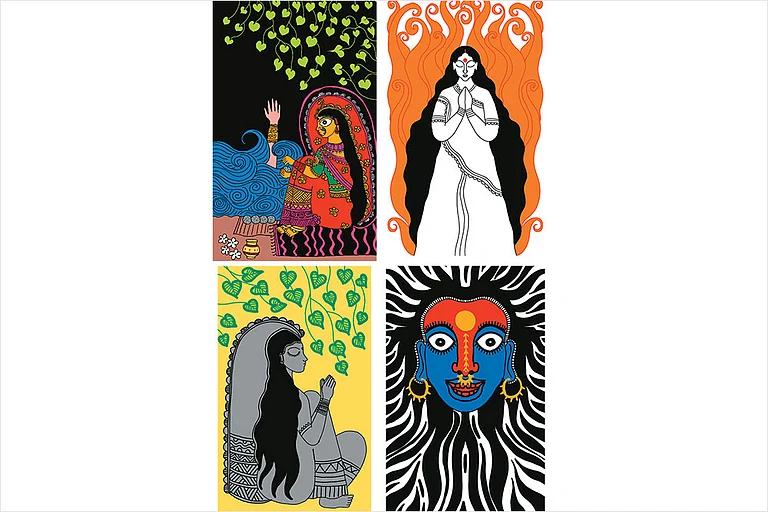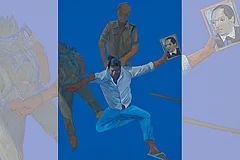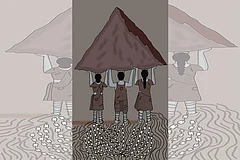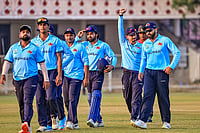Sita ke sakala dekhi jakhati jana kari
Si Sita bheli byahana jo gayo hariyargo
Bara bhamanani payela dhanusha ke dela utha gaye ho
Desha hi dhesh ke Ram ni loka ela dhanusha ke chubi chubi jaye ho
Desa baithela Sita dharma pukarti jodhe ji ta to bhaga manayo
When King Janak sees his daughter Sita’s face
He realises ruefully that his daughter is of marriageable age
The big palace is being cleaned with green cow dung
And the bow has been kept against the wall
Beautiful people from across kingdoms come, but can only touch the bow
Sita sits and prays, wondering who is fated to be her partner
Shanti Devi begins the story of Sita insisting that she encompasses the struggles of women and to see her and paint her life is to free themselves from the gaze so omnipresent that one must remind the world that she wasn’t just the wife of Ram but a woman in her own right who was also an ecofeminist. Padma Shri Shanti Devi, an expert in Mithila painting and Godna art, hails from Laheriya Ganj in Madhubani, Bihar.
She was at the Bihar Museum as part of a contingent of 30 artists from Bihar who were to paint scenes from Sita’s life as part of the Vaidehi Sita art camp cum exhibition held in Patna from July 31 to August 7. In the scene that Shanti Devi was painting, Sita was sitting in Ashok Vatika, amid lush green trees, birds and animals, and Hanuman was giving her a ring.
Shanti Devi wasn’t allowed for a long time to paint gods and goddesses as she belongs to the Paswan community, also known as Dusadh—a Mahadalit community in Bihar.
The other artists who were at an exhibition to depict various aspects of Sita’s life were experts in Mithila painting, Manjusha painting, Tikuli art, Kashidakari (embroidery and applique work) and also Sujni work. Sita, who was born in Bihar and spent her childhood in Mithila, was an artist too. It is said that Sita was inclined towards learning different art forms and scriptures. The eight-day event was a fitting tribute to Sita’s cultural and artistic legacy.
It, however, is imperative to understand why Sita was chosen as a protagonist for the exhibition. Do her stories from the bygone era hold any relevance in today’s time? The answer is yes.

In most societies, women are forced to play passive roles. They are expected to be polite and live in fear. They are forced to obey. Society expects them to be honest and to prove their innocence, they must, figuratively speaking, undergo agni pariksha (trial by fire). That is why Sita’s story has always been a source of inspiration for women, including contemporary women. Hence, it is not necessary for us to perceive Sita as a Goddess. She can be seen as an ordinary woman or the protagonist of the literary epic.
It’s irrelevant whether we believe the stories about Sita that have been narrated to us. We can consider those as stories or myths. But the fact remains that she is as relevant today as she was then. In fact, she will continue to be relevant.
The modesty in Sita’s character should be imbibed by all women. Nobody can disagree. Sita was the epitome of sacrifice and surrender. Her decision to give up the luxurious palace life and comforts that came along with that and volunteer to live in a dense forest depicts Sita’s sacrifice. She was determined and courageous. This is very much evident from the life that she led during her exile.
She never gave up and accepted all kinds of challenges. She was an intelligent woman. Her unparalleled intelligence was seen at the time of her abduction when she displayed her traits of patience and wisdom. When Ravan had abducted Sita and taken her through the vayu marg, she cleverly dropped all her jewellery pieces close to where the monkeys were sitting. This shows her far-sightedness. She knew that Ram and her brother-in-law Laxman would be able to trace her through these marks.
Sita was full of self-respect. Ravan had held Sita captive. Though she was lured, she never fell for the temptations. She outrightly rejected them. She never compromised with her self-respect. Even Ravan’s grandeur and bravery did not deter her. She did not even look at Ravan. He was scared that if he touched Sita, he would turn to ashes as she was a symbol of purity.
Sita was filled with empathy. During her stay in the forest, there had been several such incidents that showed her love and care towards animals and birds. The life of Sita is a perfect example of her sacrifice, love and duties. Though she was in captivity in Lanka, she never lost her patience. Sita is an example of women empowerment. Her life shows that women can always remain strong and brave in any situation.
Though Sita is an example of dedication and sincerity towards her husband, she also maintains her values and self-respect. Sita’s life depicts her sacrifice and penance, which inspire spiritual progress. While staying at Sage Valmiki’s ashram, she looked after her children all by herself. She taught them to be brave, obedient and polite. Sita was a perfect example of an ideal mother.
Today, we talk about women empowerment. Sita’s life should inspire all women to stand for their rights and face challenges. Decline in moral values is the biggest problem and this is leading to several other issues. Sita’s life teaches us to be honest and self-righteous.
Sita taught us to maintain a balance between duties, politeness and perseverance, values that are extremely important. In the present times, one can see a downfall in family values. The importance of family has become negligible in the process of socialisation. There is no alternative to the institution of family. Overlooking family values has led to the downfall of human beings, humanity and society. In this context, Sita’s dedication and the duties she performed as a woman are very relevant.
Sita has been a symbol of virginity. She was graceful in all situations. After Ram defeated Ravan, doubts were raised about her character. She opted for agni parisksha to prove her innocence and purity. This shows that she was a supremely confident woman. Agnidev—the God of fire—himself testified to Sita’s purity. However, many unfavourable things were said about Sita after the incident. Sita proved again that a clear conscience bears no trouble. This is a lesson for all girls to remain fearless and confident. No matter how much criticism they have to face, they should remain unbothered.
(Translated by Kaveri Mishra)
MORE FROM THIS ISSUE
Ashok Kumar Sinha currently serves as the Additional Director at Bihar Museum, Patna
(This appeared in the print as 'Sita's World')







